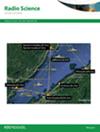射频传感器:地球静止轨道上的甚高频射频闪电探测
IF 1.6
4区 地球科学
Q3 ASTRONOMY & ASTROPHYSICS
引用次数: 0
摘要
射频传感器(RFS)是一种新型射频闪电探测器,于2021年12月发射进入地球同步轨道,并于2022年1月首次收集数据。射频传感器是一种专门的软件定义无线电接收器,可探测、记录和报告来自甚高频(VHF;30-300 MHz)范围闪电的脉冲宽带射频(RF)信号。它位于西半球地球同步轨道的有利位置,为研究美洲和太平洋雷暴持续时间内射频闪电特征的演变提供了独特的机会。它与地球静止闪电绘图仪(GOES-16 和 17)的重叠视图可对光学辐射源和相关甚高频辐射源进行更多比较,这是以前的传感器无法做到的。我们发现,RFS 优先探测明亮的甚高频信号,这些信号被称为跨电离层脉冲对(TIPPs)。据估计,在 RFS 检测到的闪电事件中,超过 85% 是跨电离层脉冲对。本文介绍了在轨运行头一年半的初步结果。本文章由计算机程序翻译,如有差异,请以英文原文为准。
Radio frequency sensor: Very high frequency radio frequency lightning detection in geostationary orbit
The Radio Frequency Sensor (RFS), a new radio frequency lightning detector, was launched into geosynchronous orbit in December 2021, and first collected data in January 2022. RFS is a specialized software-defined radio receiver that detects, records, and reports impulsive broadband radio-frequency (RF) signatures from lightning in the very high frequency (VHF; 30–300 MHz) range. Its vantage point from a Western hemisphere geosynchronous orbit provides unique opportunities to study evolution of RF lightning signatures over the durations of thunderstorms over the Americas and Pacific Ocean. Its overlapping view with the Geostationary Lightning Mappers (GOES-16 & 17) enables additional comparisons between the sources of optical emissions and associated VHF emissions that were not possible with previous sensors. We find that RFS preferentially detects bright VHF signals called transionospheric pulse pairs (trans-ionospheric pulse pairs (TIPPs)). It is estimated that more than 85% of the RFS-detected lightning events are TIPPs. This paper presents initial results from the first year and a half of on-orbit operation.
求助全文
通过发布文献求助,成功后即可免费获取论文全文。
去求助
来源期刊

Radio Science
工程技术-地球化学与地球物理
CiteScore
3.30
自引率
12.50%
发文量
112
审稿时长
1 months
期刊介绍:
Radio Science (RDS) publishes original scientific contributions on radio-frequency electromagnetic-propagation and its applications. Contributions covering measurement, modelling, prediction and forecasting techniques pertinent to fields and waves - including antennas, signals and systems, the terrestrial and space environment and radio propagation problems in radio astronomy - are welcome. Contributions may address propagation through, interaction with, and remote sensing of structures, geophysical media, plasmas, and materials, as well as the application of radio frequency electromagnetic techniques to remote sensing of the Earth and other bodies in the solar system.
 求助内容:
求助内容: 应助结果提醒方式:
应助结果提醒方式:


